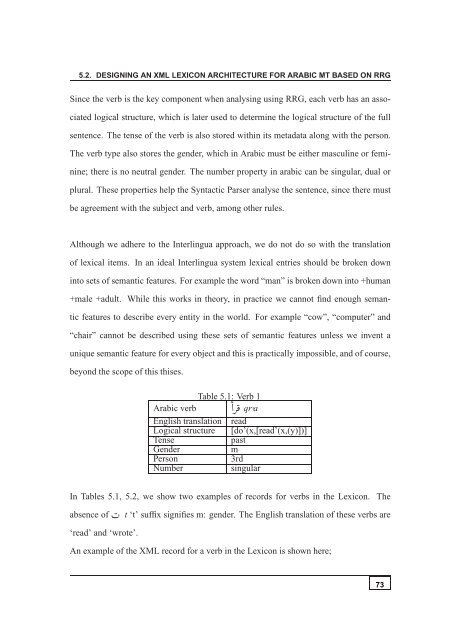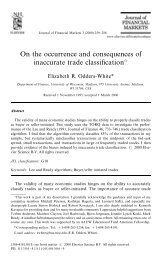A generic framework for Arabic to English machine ... - Acsu Buffalo
A generic framework for Arabic to English machine ... - Acsu Buffalo
A generic framework for Arabic to English machine ... - Acsu Buffalo
You also want an ePaper? Increase the reach of your titles
YUMPU automatically turns print PDFs into web optimized ePapers that Google loves.
5.2. DESIGNING AN XML LEXICON ARCHITECTURE FOR ARABIC MT BASED ON RRG<br />
Since the verb is the key component when analysing using RRG, each verb has an asso-<br />
ciated logical structure, which is later used <strong>to</strong> determine the logical structure of the full<br />
sentence. The tense of the verb is also s<strong>to</strong>red within its metadata along with the person.<br />
The verb type also s<strong>to</strong>res the gender, which in <strong>Arabic</strong> must be either masculine or femi-<br />
nine; there is no neutral gender. The number property in arabic can be singular, dual or<br />
plural. These properties help the Syntactic Parser analyse the sentence, since there must<br />
be agreement with the subject and verb, among other rules.<br />
Although we adhere <strong>to</strong> the Interlingua approach, we do not do so with the translation<br />
of lexical items. In an ideal Interlingua system lexical entries should be broken down<br />
in<strong>to</strong> sets of semantic features. For example the word “man” is broken down in<strong>to</strong> +human<br />
+male +adult. While this works in theory, in practice we cannot find enough seman-<br />
tic features <strong>to</strong> describe every entity in the world. For example “cow”, “computer” and<br />
“chair” cannot be described using these sets of semantic features unless we invent a<br />
unique semantic feature <strong>for</strong> every object and this is practically impossible, and of course,<br />
beyond the scope of this thises.<br />
Table 5.1: Verb 1<br />
<strong>Arabic</strong> verb qr֓a<br />
<strong>English</strong> translation read<br />
Logical structure [do’(x,[read’(x,(y)])]<br />
Tense past<br />
Gender m<br />
Person 3rd<br />
Number singular<br />
In Tables 5.1, 5.2, we show two examples of records <strong>for</strong> verbs in the Lexicon. The<br />
absence of t ‘t’ suffix signifies m: gender. The <strong>English</strong> translation of these verbs are<br />
‘read’ and ‘wrote’.<br />
An example of the XML record <strong>for</strong> a verb in the Lexicon is shown here;<br />
73
















